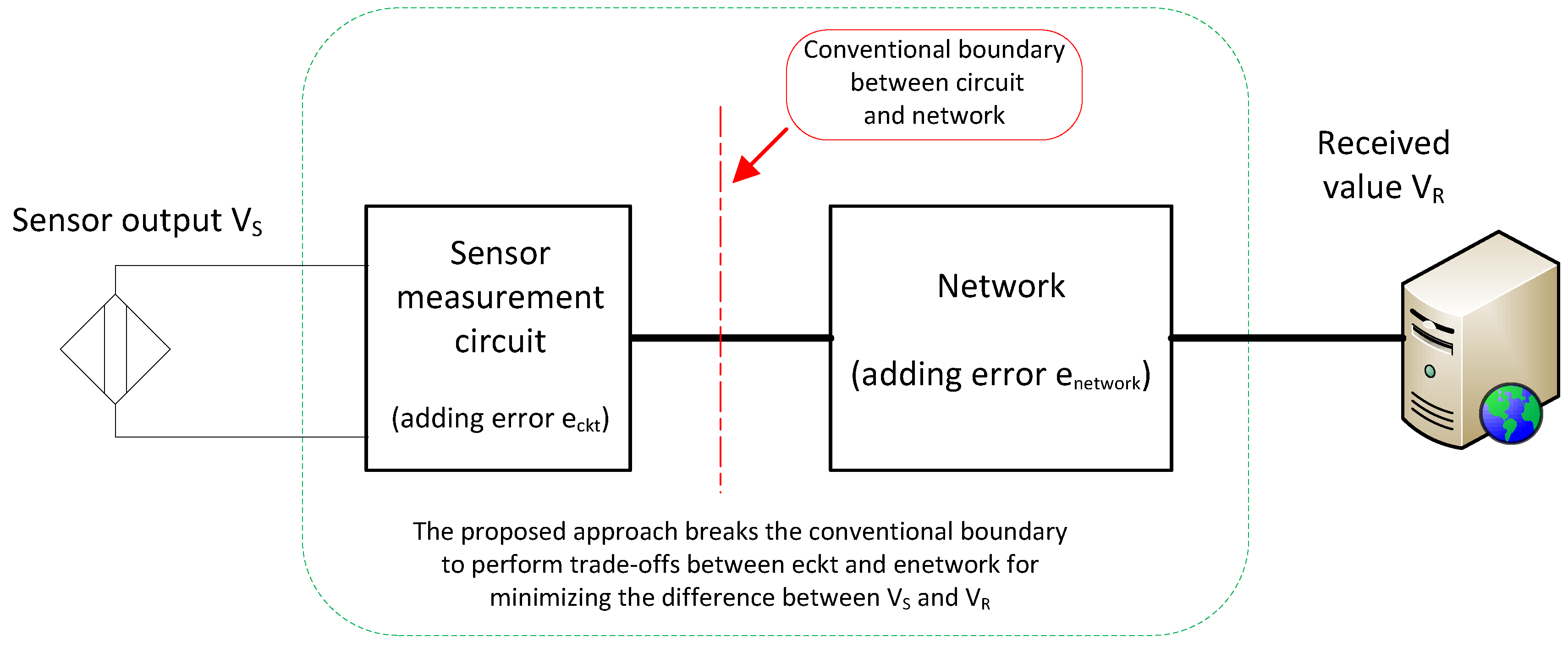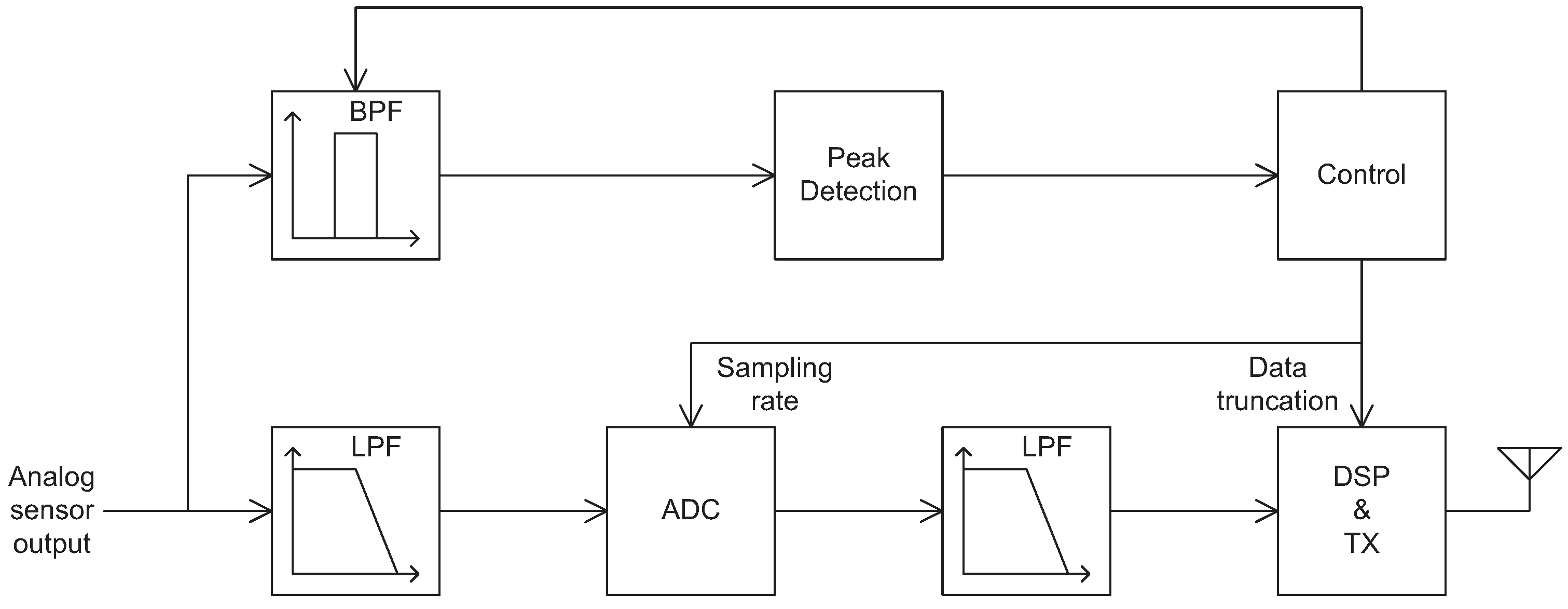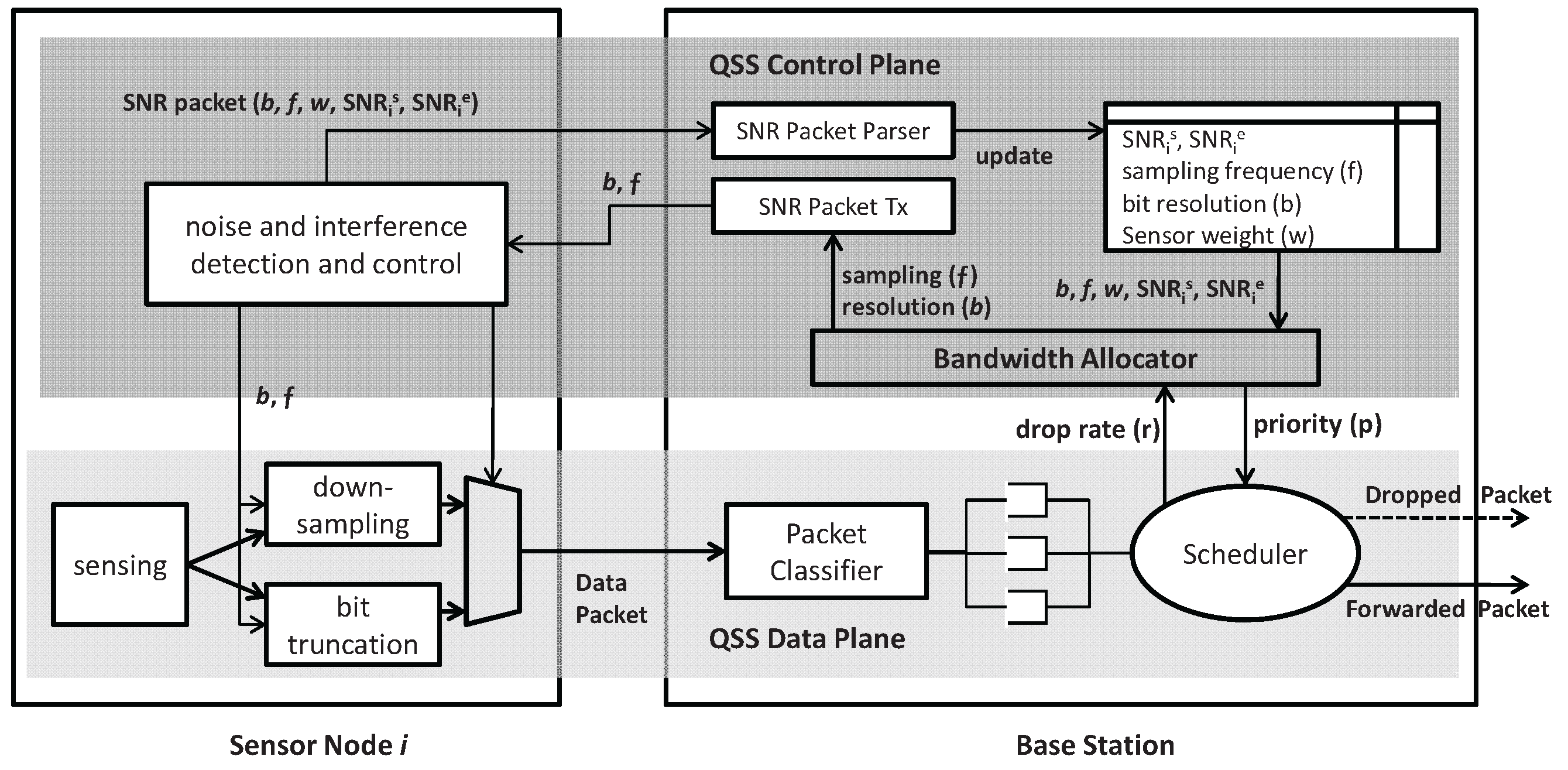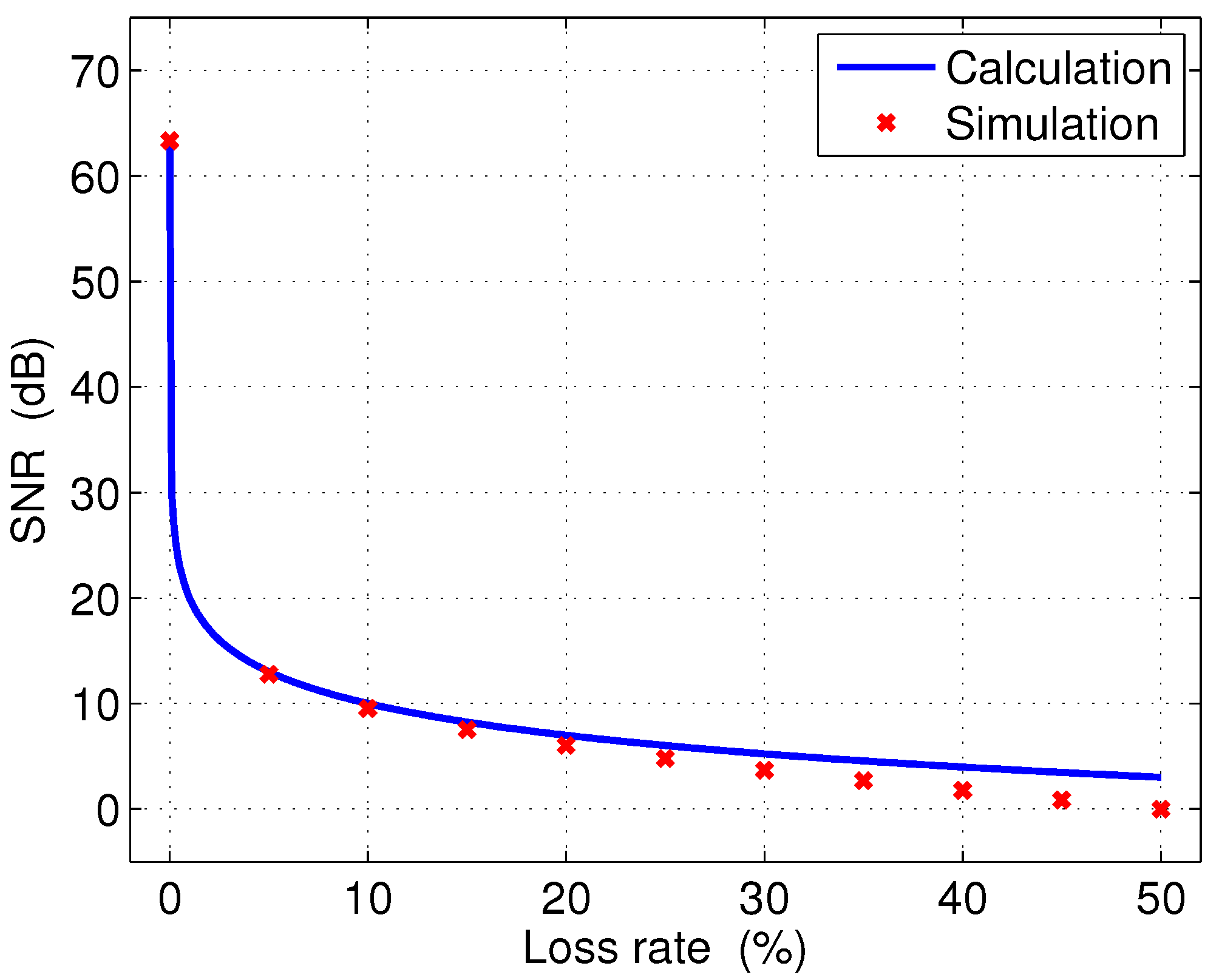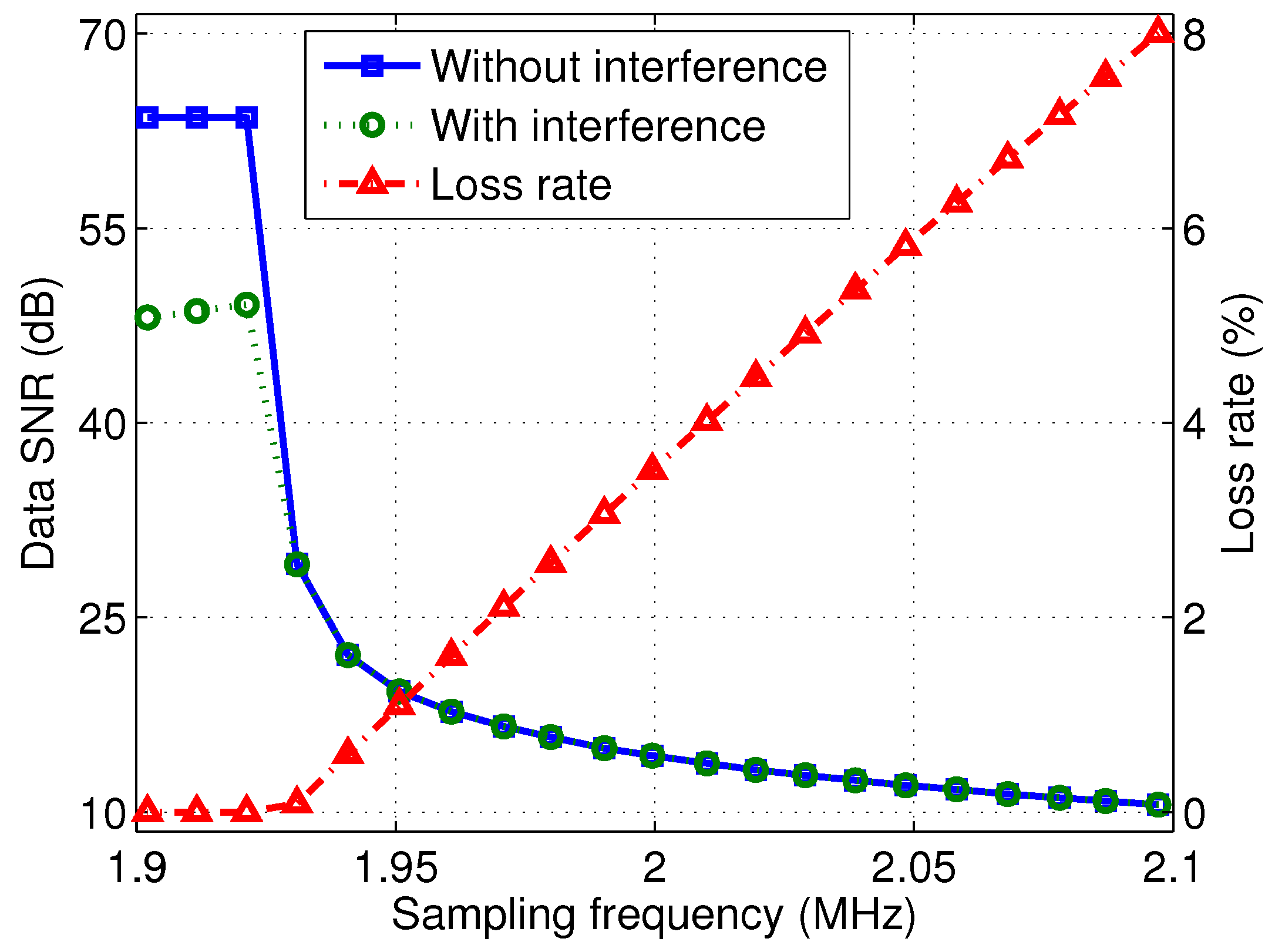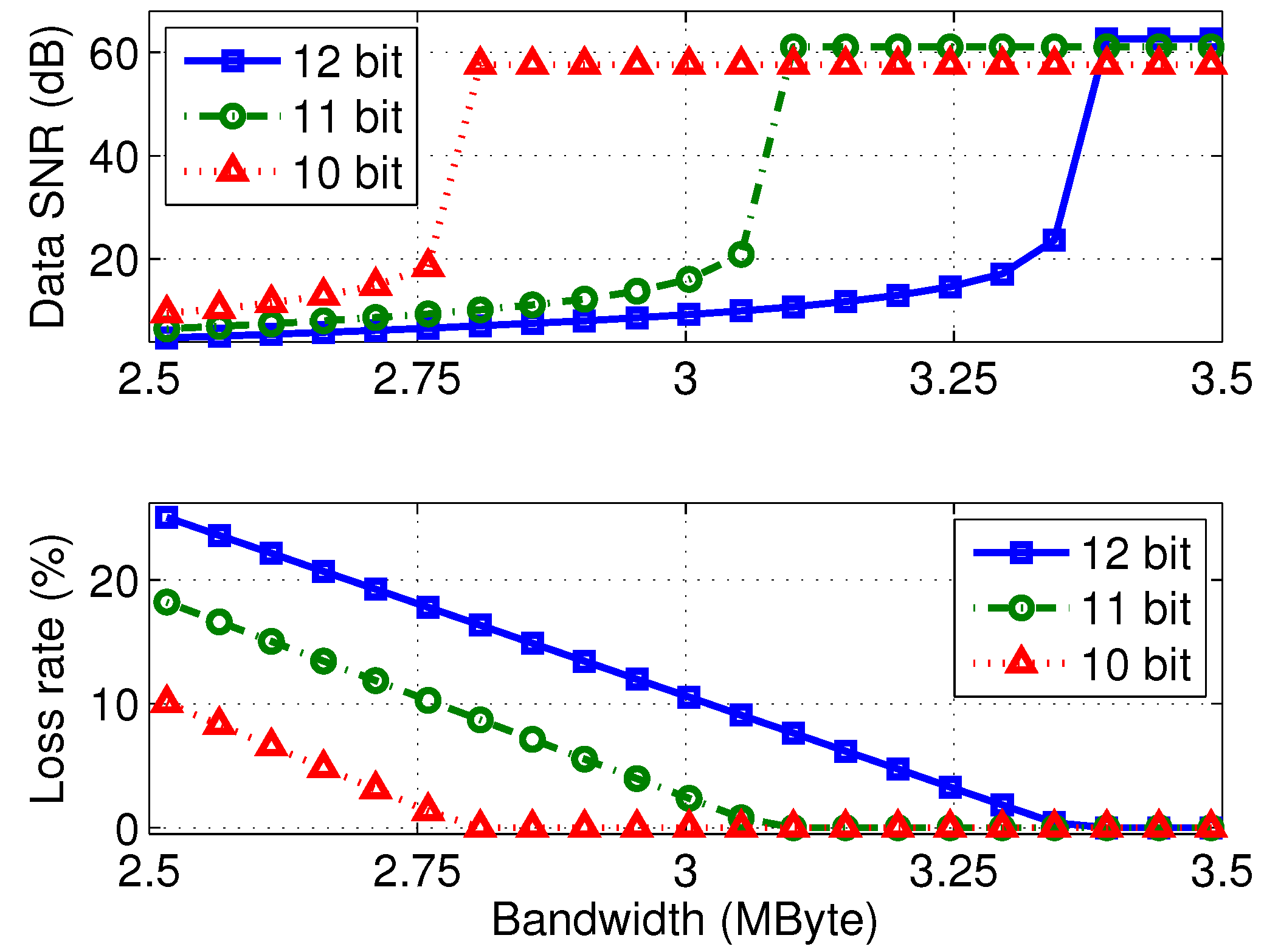1. Introduction
An important characteristic of wireless sensor networks is that sensor nodes in such systems normally have miniature sizes, low power consumption, and limited computation and communication capabilities. This is to make wireless sensor networks cost-effective and suitable for being deployed in various environments. The above constrains also pose significant challenges on designing and managing wireless sensor networks. Techniques that have been proposed to address these challenges include: efficiently transmitting network packets [
1,
2,
3,
4,
5,
6], sensor information fusion [
7,
8,
9,
10], and adaptive sensor networks [
11,
12,
13]. In the conventional design paradigm, the designs as well as the operation of the circuit and network are treated separately. During operation, the circuit feeds data to the network according to predetermined specifications (e.g., throughput, bit size,
etc.). The condition of the network (e.g., congestion) is blinded from the circuit and hence the circuit typically does not adjust its operation according to the network condition. Meanwhile, the network does not have to consider the accuracy (or quality) of the data fed from the circuit. It simply strives to transmit all the incoming data to the receiver. The above separation, as illustrated by the dash line in
Figure 1, is naturally formed due to the fact that the circuit and network designs involve different technical expertise and such separation often simplifies the design process. However, this separation does not allow effectively performing trade-offs between errors caused by circuit and network. The ability to perform such trade-offs can help minimize data quality degradation in congested network.
Figure 1.
Separation of sensor circuit and network in conventional sensor network design paradigm.
Figure 1.
Separation of sensor circuit and network in conventional sensor network design paradigm.
This work presents a framework to allow sensor networks intelligently performing trade-offs between errors caused by circuit and network. It is based on data quality defined in term of signal to noise ratios (SNR). In sensor networks, physical parameters or signals are sensed by sensor nodes and transmitted via the networks. In this process, noises are inevitably added to the signals due to external interferences, circuit intrinsic noise and network packet loss. The condition of the signal in sensor networks can be characterized by signal SNR. To guarantee the integrity of received sensor signals, sensor networks often pose SNR requirements for the received sensor
data [
14,
15].
The SNR studied in this work is different from the SNR that has been used as the means to measure the quality of sensor communication channels [
16,
17,
18,
19], in which SNR reflects the strength of the carrier signal over the power of the noise at the wireless communication channels. Such SNR does not reflect the quality of
data transmitted by the sensor networks. On the contrary, the SNR studied in this work measures how accurately a physical parameter (e.g., vibration speed) being monitored is represented by the data contained in network packets. Thus, we also refer to the SNR studied in this work as
data SNR. A sensor network may have perfect communication links (high SNR for communication links), but the received data may not accurately represent the real value of the physical parameter being sensed (e.g., due to poor sensing environment) and hence it has low data quality (low data SNR). The data SNR studied in this work is similar to quality of service (QoS) issues that have been intensively studied for wireless cellular networks [
20,
21] and Internet-based applications [
22,
23,
24]. However, QoS techniques developed for these applications may not be suitable for wireless sensor networks due to the limited computation power of sensor nodes.
Data SNR can be affected by the sensing environment, non-ideal factors associated with sensing devices and circuits, and network packet loss during data communication. While issues affecting data SNR in sensing environment as well as at sensor nodes have been intensively investigated, the relation between data SNR and network packet loss has not been thoroughly studied yet. Although it is widely agreed that packet loss negatively affects the SNR of data being transmitted in networks, to the best of our knowledge no equations that quantitatively describe the relations between data SNR and packet loss rate in sensor networks have been reported in literature.
In this study, the impact of packet loss on data SNR in sensor networks is analyzed and a closed-form expression is derived to estimate data SNR degradation caused by network packet loss. The second contribution of this paper is to introduce an SNR-based metric to measure data quality in sensor networks. The proposed metric represents one of the many facets (specifically, how satisfactorily senor network data meet the SNR requirement) about the quality of sensor network data. It can be incorporated with other quality metrics to more comprehensively assess data quality in sensor networks. The combination of the developed SNR estimation equation and SNR-based quality metric paves the way for more intelligent network congestion control to minimize data quality degradation from the aspect of data SNR. Finally, the paper presents a cross-layer adaptive scheme for minimizing data quality degradation in congested sensor networks. The uniqueness of the proposed approach comes from the following two aspects: (1) it intelligently trades-off intentional SNR reduction at sensor node circuits and undesirable SNR degradation caused by packet loss at network level; (2) it seamlessly incorporates low-level circuit operations and high-level network operations in sensor network congestion control. The validity and effectiveness of the proposed techniques are demonstrated by our simulation experiments.
The rest of the paper is organized as follows.
Section 2 discusses the impact of packet loss on data SNR and derives the SNR estimation equation. In
Section 3, the SNR-based data quality metric is first introduced and then cross-layer adaptive techniques are presented to minimize data quality degradation in congested sensor networks.
Section 4 presents simulation results and the paper is concluded in
Section 5.
2. Impact of Network Packet Loss on Data SNR
As discussed early, sensor nodes sense and digitize the physical parameters being monitored and the sensed data are subsequently transmitted by the network. At the sensor node level, environmental interference and non-idealities of the sensor circuit inject noise to the signal. Meanwhile, at the network level, packet loss due to network congestion and other factors can also degrade data SNR and affect data quality. Since the quantitative relation between packet loss and data SNR degradation has not been widely studied for sensor networks, we first derive analytical equations to analyze how data SNR is affected by packet loss rate (l) in sensor networks.
Because any signal can be treated as a combination of a group of sinusoidal signals, a single-tone sinusoidal signal is used in this study. The use of sinusoidal signals in SNR analysis is widely adopted in circuit, communication and signal processing communities. At the sensor node output, the signal to noise ratio, denoted by
SNRT, of the transmitted data is:
where
Ps,
Pn,
Pq are the power of the signal, environmental noise and quantization noise, respectively.
Figure 2.
Modeling lost packets as noise.
Figure 2.
Modeling lost packets as noise.
The impact of lost packets can be equivalent to the signal being altered by adding a deterministic noise that has the same magnitude but opposite phase as the lost signal. This is illustrated in
Figure 2. The
incomplete signal is the composite of an ideal signal and the deterministic noise on the right. Thus, the data SNR at the network receiving end (denoted by subscript
R) can be expressed as:
where
Pd is the power of the missing signal due to packet loss.
Without losing generalities, we assume the magnitude of the signal is
A and the data in a packet payload cover a portion of the signal from phase
θ1 to
θ2. Then, the power of the signal contained in one packet can be expressed as:
where
ϕ is the phase difference between
θ1 and
θ2. Normally,
θ1 is uniformly distributed from 0 to 2
π. Thus the average power of each packet is proportional to the packet size as:
The power of the lost packets from
M transmitted packets can be derived:
Note that the term of
in the above equation represents the total signal power of the
M packets. Thus we have:
Subsequently, the SNR at the receiving end can be described by:
The derived equation indicates that packet loss has a significant impact on data SNR. Therefore, it is critical to maintain low packet loss rate in order to prevent dramatic SNR degradation. Note that the above discussion assumes no data compression and coding are performed at sensor nodes. Although some sophisticated sensors, such as audio or video sensors, do perform data compression and coding operations before loading the data to the network, there also exist a large number of simple sensor nodes, such as sensors monitoring temperature, velocity, acceleration, etc., that do not perform data compression and coding due to (1) marginal benefit of data compression and coding and (2) tight power budget and limited computation capability at the sensor nodes.
3. Techniques to Minimize Data Quality Degradation in Congested Networks
This section presents a framework to minimize data quality degradation caused by packet loss in congested networks. First, an information quality metric for sensor network data is developed based on the following observations. To accurately reflect the conditions of the objects being monitored, the SNR of the data transmitted by the sensor networks should be maintained at certain levels such that noise signals will not lead to false operation or detection. For the convenience of discussion, we use to denote the required or expected SNR of the data coming from sensor i. The selection of value is highly application-specific and strongly depends on the characteristics of the sensors.
Once the SNR of the sensor data reaches the required
SNRE level, the sensor data will provide adequate accuracy for the target application. Further improving data SNR normally has marginal benefits for the target application. Therefore, from the SNR perspective, we can define the quality of data associated with sensor node
i as:
where
and
are the actual and expected SNR values at the receiving end of the network for sensor node
i. We cap the maximum value of
q to 1 to reflect the diminishing improvement on data quality when
SNRR is becoming larger than
SNRE. While the above definition measures the quality of data collected by a single sensor, the overall quality of data gathered by the entire sensor network can be assessed by a weighted sum of the data quality parameter
q for all the sensor nodes. This is:
where weight parameter
wi represents the importance level of sensor
i in the network. Similar to
SNRE, the values of
wi are selected according to the nature of the application and the type of sensors.
The above quality metric can be explained with the example shown in
Figure 3. For the illustrative purpose, we assume the sensor network is composed of three sensor nodes and a base station. The expected SNR and weight parameter for each sensor node are listed in the table beside the base station symbol. The SNR values listed below the sensor node symbols are the actual data SNR at sensor outputs. Since the SNR at sensor outputs are affected by sensor environment factors as well as sensing circuit conditions, their values often fluctuate from time to time. In most sensor-networks, the sensor nodes are designed to be able to maintain the required SNR in the worst operating conditions. As a result, the SNR at the sensor output may be higher than the desired value when the sensor node does not experience the worst operating condition.
Figure 3.
SNR values in an illustrative sensor network.
Figure 3.
SNR values in an illustrative sensor network.
If the network communication channel is perfect, the data received by the base station will have the same SNR as that at the sensor outputs. Hence, the data quality metric, defined by Equation (
9), will have its maximum value 1. However, when the network bandwidth is adversely affected and the network becomes congested, the lost packet will significantly affect the data SNR at the base station side as indicated by Equation (
7). For example, we assume the network congestion causes a packet loss rate of 0.1%. The SNR of data received by the base station is reduced to about 30 dB for all the sensors. (The fact that the received data from all the three sensors approximately have the same SNR level is primarily due to the dominant impact of packet loss rate
l in Equation (
7). Subsequently, the network data quality defined by Equation (
9) is degraded from the ideal value 1 to 0.7, which clearly manifests the significant impact of packet loss rate on data quality from the SNR perspective. To effectively minimize data quality degradation in congested sensor network, a scheme that incorporates both low-level circuit operation and high level network scheduling techniques is discussed as follows.
3.1. Circuit Level Operations for Reducing Network Congestion
A simple approach to reduce network congestion is to decrease the amount of data generated by sensor nodes. Previously proposed techniques to reduce data from sensor nodes focus on minimizing the time duration (duty cycles) of sensors being activated [
25,
26]. However, duty cycle minimization methods may not be suitable for applications that require sensors to continuously monitor the objects. To avoid this drawback, the proposed framework uses
data bit truncation and
down sampling approaches to reduce the amount of data generated by sensor nodes. In addition, the proposed techniques can be incorporated with the previous duty cycle minimization techniques to more effectively reduce network congestion.
In the data bit truncation approach, the least significant bits (LSBs) of the sensor data can be adaptively truncated according to the noise level as well as the amount of data that need to be trimmed. On one hand, the bit truncation approach can be very effective to reduce the amount of data generated by the sensor node. On the other hand, bit truncation can also potentially cause significant SNR reduction at the sensor output if it is not conducted properly. However, in scenarios that sensor nodes experience large noise and the levels represented by LSBs (less significant bits) are below the noise level, truncation LSBs of sensor output may not have significant impacts on data SNR. The noise level can be detected by the proposed sensor circuit to be discussed shortly. With the measured noise level, the SNR can be estimated and hence the effective number of bits (ENOB) of the sensor data can be calculated. The difference between ENOB and the current bit size of the sensor data can be used to guide how aggressively bit truncation to be performed.
The second approach of reducing sensor data is to decrease the sampling rate used in the analog-to-digital conversion (ADC) at the sensor node circuit. Note that the meaning of the sampling rate here is different from that in [
25,
26], where the sampling rate refers to how frequently the sensor nodes are activated. According to Nyquist–Shannon sampling theorem, the minimum sampling frequency is twice of the bandwidth of the sensor output signal. However, in practical designs the sampling frequency is normally higher than the theoretical minimum requirement in order to minimize noise aliasing caused by the slow drop-off of anti-aliasing filters in sensor signal paths [
27,
28,
29,
30]. Note that most sensor nodes are designed for the worst-case scenarios. Thus the selected sampling frequency is often in the conservative side. When the sensor does not experience the worst-case noise scenarios, it is possible to reduce the sampling frequency without causing significant aliasing.
In a congested sensor network, whether to perform bit truncation or down sampling (as well as how aggressively to perform such operations) on sensor nodes has to be determined in the field according to the sensor operating environment. To enable sensor nodes to make such intelligent decisions, we present a sensor circuit structure as shown in
Figure 4. In addition to the conventional signal chain in a sensor circuit, a programmable bandpass filter (BPF), peak detection circuit and a simple control circuit are added to the intelligent sensor circuit. To analyze the noise spectrum, the passband of the programmable band-pass filter is programmed to sweep a wide frequency spectrum, which is about several times of the bandwidth of the anti-aliasing filter. Meanwhile, the peak detection circuit senses the noise level at each frequency segment swept by the programmable band-pass filter. Since only a rough estimation of the noise level is needed, the programmable band-pass filter and peak detector can be implemented using simple and power-efficient circuits. Such circuits have been used as low-overhead built-in-self-testing (BIST) circuits [
31,
32,
33] and hence adding these circuits to sensor node circuits will not cause significant overhead. The energy consumed by the band-pass filter, peak detector, and control circuit is also small because these components are not frequently activated and, if activated, their operations only last for a short time period.
Figure 4.
Sensor node circuit used in the proposed quality enhancement framework.
Figure 4.
Sensor node circuit used in the proposed quality enhancement framework.
3.2. Network-Level Operation for Minimizing SNR Degradation
Relying on the intelligence of the sensor nodes alone will not be sufficient to address the data quality degradation in congested networks. High-level coordinations and optimizations are essential parts of the proposed data quality enhancement scheme. To carry out such network-level operations, we propose a quality-aware scheduling system (QSS) architecture. The functional blocks of the QSS architecture are shown in
Figure 5. To better illustrate the data and control flows in proposed framework, a sensor node is drawn along with the base station (or router) in the figure. During the sensor network operation, a small number of packets, referred to as control or SNR packets, are dedicated for sensor nodes to update the routers about the noise characteristics in their sensing environment. Also, routers use control packets to administrate the sampling frequency and data resolution of each sensor node in the process to minimize data quality degradation due to congested network conditions. Compared with data packets (which carry data sensed by the sensors), the number of control packet is very small and, thus, the control packets will not aggravate the congestion level of the network.
Figure 5.
Quality-aware scheduling system (QSS) architecture.
Figure 5.
Quality-aware scheduling system (QSS) architecture.
Depending on the type of packets that it handles, the functionality of the proposed system can be partitioned into control plane and data plane, which are indicated by different shadings in
Figure 5. The QSS control plane in a router consists of SNR packet parser and transmitter (Tx), sensor table and bandwidth allocator. The sensor table maintains sensor information (
,
, frequency (
f), sensor weight (
w), data resolution (
N)) according to SNR packets. The bandwidth allocator uses the SNR information to calculate data quality
qi for each sensor when the network becomes congested. It also determines how much data throughput from each sensor node should be reduced and, subsequently, sends out control packets to sensor nodes to implement such reduction. The physical implementation of the throughput reduction is carried out at sensor nodes via bit truncation or down sampling as discussed early.
Two general principles can be followed by the bandwidth allocator in determining how to reduce each sensor node’s throughput when the network becomes congested. First, sensors whose output data have SNR higher than the expected value SNRE should be the first group to perform downsampling or bit truncation. According to the noise characteristics faced by the sensors as well as the difference between the current and expected SNR values, the bandwidth allocator can determine how aggressively the downsampling or bit truncation needs to be performed. Second, for sensors that have low weight (w) values, degrading their individual data quality has relatively less impact on the overall data quality of the system. Thus, more SNR reduction (more aggressive downsampling or bit truncation) can be tolerated by these sensor nodes in QSS operations.
In addition to intelligently assigning throughput reduction for sensor nodes, the router can further minimize data quality degradation by applying different scheduling schemes for packets originated from different sensor nodes. In the QSS data plane of a router, incoming data packets are distributed to different queues by the packet classifier. The packet scheduler selects a queue for dequeuing depending on the priorities set by the bandwidth allocator. In congested networks, the low-priority packets experience higher packet loss rate compared with packets with high priorities. Again, there are two principles followed by the bandwidth allocator to assign priorities. First, packets originated from sensors with low weight values have low priorities since SNR degradation (due to packet loss) for the low-weight sensors has less impact on the overall data quality of the sensor network. Second, for a group of sensors that have the same weight, packets from the sensors that have high expected SNR values should be given higher priorities compared with packets from sensors with low expected SNR values. This is because the impact of packet loss is less severe for data with low SNR values compared with data with high SNR values as indicated by Equation (
7). Based on the above principles, heuristic algorithms can be implemented in the bandwidth allocator for the proposed framework. The algorithms [
34] that we have developed demonstrated excellent potentials in minimizing data quality degradation in congested sensor network.
4. Simulation Results
4.1. Verification of SNR Degradation and Packet Loss Relation
Simulations are conducted to verify the accuracy of the derived relation on SNR degradation and packet loss rate. In the simulation setup, emulated sensor output signal is generated by MATLAB programs. The SNR of the emulated sensor signal is 63 dB. The signal is digitized into 12-bit digital data and packed into 512-byte packets. For a given packet drop rate, packets are randomly dropped in simulation and, meanwhile, efforts are made to guarantee the ratio of dropped packet count over the number of total packets is equal to the packet drop rate. After the above packet dropping process, the SNR of the data constructed from the remaining packets are calculated to obtain SNR degradation caused by the dropped packets. In the simulation, we vary the packet drop rate from 0 to 50% and the SNR degradation obtained from simulation are plotted as the solid line in
Figure 6. Meanwhile, the SNR degradations predicted by Equation (
7) are plotted with the asterisk symbols in the figure. It shows a close agreement between the SNR degradations predicted by the equation and that obtained from simulation.
Figure 6.
Comparison of estimated and simulated SNR degradation.
Figure 6.
Comparison of estimated and simulated SNR degradation.
4.2. Studying the Effectiveness of Circuit Level Operations on Enhancing Data Quality
The following simulation results demonstrate the effectiveness of the proposed circuit-level adaptive operations on alleviating SNR degradation caused by packet drop in congested sensor networks. Similar to the previous experiment setup, emulated sensor output is used in the simulation. In the beginning of simulation, the emulated sensor signal is sampled at 2.1 Mega Samples per second (MS/s) and each sampled data is digitized into a 12-bit data. The sensor signal frequency is 419.456 kHz and is filtered by a 2nd-order anti-aliasing filter with a bandwidth of 503 kHz. The obtained data are encapsulated into network packets. The packet size is 512 bytes and the head size is 32 bytes. Hence, the emulated sensor node generates a data stream of 3.356 MB per second. In ideal operation scenarios, sufficient network bandwidth is allocated and no packets are dropped. Hence, the SNR at the receiver end should be the same as the SNR at the sensor output, which is 63 dB in the simulation setup.
In the following simulation, we take a simple approximation: the network can only reliably transfer the amount of data equal to its allocated capacity and simply drop the rest of data. For example, if the sensor node keeps the same data throughput and the network bandwidth is reduced to 92%, then the network can reliably transfer 92% of the packets generated by the sensor node and a randomly selected 8% of the total packets will be dropped. Although the above treatment may unrealistically simplify the relation between packet drop rate and network bandwidth reduction, it does not invalidate this study due to the following reason. The packet loss rate obtained from the above simplification is likely lower than the actual packet loss rate of a real sensor network with reliable transfer mechanisms. As a result, the simulation setup in this study leads to a pessimistic estimation on the effectiveness of the proposed techniques on reducing network congestions. Note that only one sensor node is used in the study. This is because the techniques evaluated in this subsection belong to circuit level. Multiple sensor nodes will be used in the experiments to evaluate network level operations.
In the simulation experiment, we reduce the network bandwidth to 3.088 MB, which is 92% of the minimum required bandwidth. To cope with the reduced network bandwidth, the downsampling technique is first applied in the simulation experiment, in which the sampling frequency is varied from 2.1 MS/s to 1.9 MS/s. Two noise scenarios are considered in the study. In the first scenario, the noise contained in the sensor output signal is white noise and in the second scenario a strong third harmonic interference signal (three times of the desired sensor signal frequency) is present at the sensor output. The resultant SNR values at the network receiving end for different sampling frequencies are plotted in
Figure 7. Clearly, if the sensor node keeps the original sampling frequency (2.1 MS/s) after the network bandwidth is adversely affected, the packet loss rate is elevated to 8% and, subsequently, large SNR degradations occur in the sensor network. The simulation results show that when the sampling frequency is reduced to 1.93 Ms/s the dramatic SNR degradation caused by packet loss is avoided. Note that the presence of harmonic noise makes the final SNR lower than that in the white noise only scenario.
Figure 7.
Data SNR and packet drop rates with different sampling frequencies.
Figure 7.
Data SNR and packet drop rates with different sampling frequencies.
In addition to down sampling, bit truncation can also be used to reduce network congestion, especially when the sensor nodes experience elevated noise floors.
Figure 8 shows how bit truncation effectively copes with network bandwidth reduction in our simulation experiments. The same sensor output data and packet size used in the previous experiments are used in this study. Also, the sampling frequency is fixed at 2.1 MS/s but the network bandwidth is varied from 3.5 MB/s to 2.5 MB/s in this experiment. As discussed early, the sensor node generates a stream of data of 3.356 MB/s when the data bit width is 12 bit. As shown by the solid line with square legend in
Figure 8, when the network bandwidth is reduced below the 3.35 MB/s, the SNR observed at the receiving end starts to degrade due to packet drops. However, if the bit width of sensor data is truncated to 11-bit or 10-bit, the data SNR at the receiving end can be maintained at high values till the network bandwidth is reduced to 3.1 MB/s or 2.8 MB/s, respectively.
Figure 8.
Data SNR and packet drop rates with different data bit widths.
Figure 8.
Data SNR and packet drop rates with different data bit widths.
4.3. Studying the Effectiveness of Network Level Operations on Enhancing Data Quality
To study how network-level operations in the proposed framework facilitate minimizing data quality degradation, simulations are conducted to compare the data quality for three different strategies that are used by the network to cope with congested traffics. For the convenience of discussion, we refer to the three strategies as: passive, reactive without priorities and reactive with priorities. In passive strategy, the base station does not react to changes in bandwidth by maintaining the same sampling frequency and data bit width for all the sensor nodes. In the approach of reactive without priorities, if degradation in bandwidth is experienced, the base station reduces the sampling rates of all sensors proportionally. In the approach of reactive with priorities, sensors are assigned a priority in the range of zero to one. This priority determines how much we can reduce the sampling rate of a sensor and also how much a sensors quality contributes to the overall quality metric (Q). If the network experiences a decrease in bandwidth, the sampling rates of the lower priority sensors are reduced before those of high priority sensors as their data are redundant. This allows the network to maintain a higher level of information quality during times of bandwidth degradation.
In our experiment, we make the following assumptions. We are aware of the initial available bandwidth and allocate 90% of it to the sensors. After this initial bandwidth distribution, it is assumed that the only indication of bandwidth degradation that the base station receives is an increase in dropped packet rates. The base station uses this as a signal to react and reduce rates, either with or without priority. We examine a network where sensors are grouped by twos, one with a priority of 1 and the other redundant sensor with a priority of 0.1.
Figure 9 shows the data quality (y1-axis) adapting to bandwidth degradation (y2-axis) over simulation time (x-axis). The solid line indicates reactive with priorities, the largest dashed line indicates reactive without priorities, and the mid-sized dashed line indicates passive. The smallest dashed line indicates the percent of bandwidth degradation with a larger percentage indicating less bandwidth. The software simulation is performed using Network Simulator (NS 2.34).
Table 1 lists the key simulation parameters used in simulation. There is a tradeoff between update frequency and quality gain due to control packet overhead. However, it is difficult to estimate the overhead accurately because it depends on update frequency, sensor network topologies, and potential applications characterization. Nevertheless, the overhead of control packets is negligible compared with the data packets of sensors. This result shows that assigning priorities to sensors allows the network to maintain a higher data quality when bandwidth degrades. It also shows that, when bandwidth degrades to a certain level, the sampling rates of low priority sensors cannot be reduced anymore and because of this, reactive with priority and reactive without priority eventually merge. However, utilizing priorities allows for data quality to be maintained under very strenuous bandwidth constraints.
Figure 9.
Quality adapting to link bandwidth degradation using different QSS configurations.
Figure 9.
Quality adapting to link bandwidth degradation using different QSS configurations.
Table 1.
Key parameters used in NS simulation.
Table 1.
Key parameters used in NS simulation.
| Parameter | Values |
|---|
| number of sensors | 10 |
| SNRe range | 28–40 |
| link bandwidth (Kb/s) (sensors to base station) | 100 |
| initial link bandwidth (Kb/s) (base station to home station) | 100 |
| initial link utilization (base station queue size (number of packets) | 50 |
| default base station queue type (passive) | droptail |
| link delay (ms) (all links) | 5 |
| bandwidth distribution | proportional to SNRe |
| Traffic Type | UDP |
| sample packet size (bytes) | 65 |
| sensor redundancy (%) | 50 |
| network topology | tree |
5. Discussion and Future Work
This work analyzes the impact of network packet loss on the SNR of the data transmitted by sensor networks. A closed-form relation is derived to estimate SNR degradation for a given packet loss rate. The estimated results are in close agreement with simulated SNR degradations. The study indicates that packet loss has dramatic impact on SNR degradation for uncoded sensor data transmitted in sensor networks. Currently, the SNR issue has not yet attracted significant attention in sensor network design, which, we believe, is due to the following reasons. At present, most sensor nodes employed in sensor networks fall in the two ends of the complexity spectrum. The high-end senor nodes, such as the ones that can capture and transmit video and audio signals, normally rely on sophisticated data coding and high-level quality of service (QoS) control techniques to address the quality of data. Typically, these sophisticated techniques require significant computation power and, subsequently, lead to bulky, expensive or power-hungry sensor nodes, which makes them unsuitable for cost-sensitive applications. On the other end of the spectrum, miniature and simple sensor nodes are currently used to sense simple data, e.g., sensing the temperature or humidity at a given time. As a result, data transmitted by these sensors are static data and do not have SNR requirements for continuous time periods.
With the development of new sensing devices and sensor-network technologies, new applications will emerge with the demand for low-power miniature sensor nodes as well as SNR requirements for sensor data. However, the data coding and QoS techniques used in the current high-end sensor nodes may not satisfy the power budget and cost considerations in these applications. To address this challenge, this work presents a framework to effectively minimize data quality (in terms of data SNR) degradation in congested sensor network. The framework consists of: (1) an SNR-based metric to measure data quality; (2) techniques for enabling sensor nodes to intelligently reduce data throughput in congested network conditions; (3) a quality-aware network system to coordinate sensor node adaptive operations and carry out prioritized packet scheduling. The validity of the proposed approach is demonstrated by simulation in this work. Currently, we are developing hardware infrastructures that will enable us to demonstrate and experiment the proposed techniques on a wireless sensor network platform. Improvements of the proposed cross-layer data quality enhancement techniques will be investigated in the future based on hardware experiments. Also, the current study assumes that sensor nodes directly send data to a base station. In the future, we would like to extend the study to sensor networks that support multi-hop communications.
